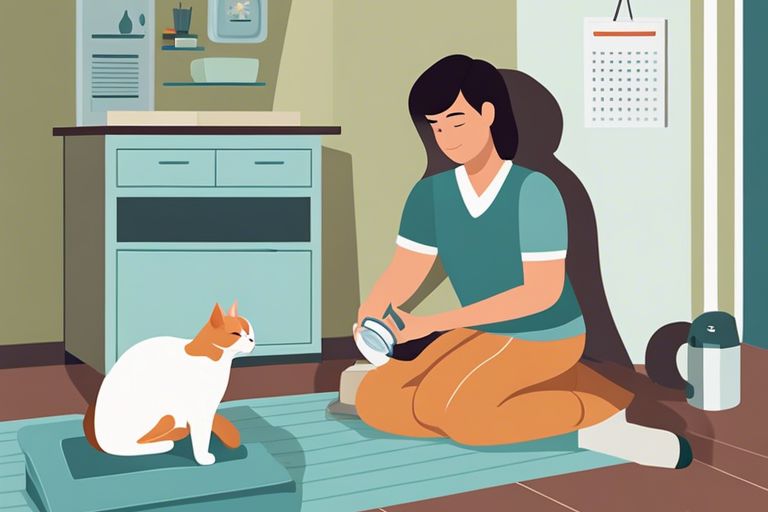Dealing with a broken bone in your cat can be a stressful and worrisome experience. However, it’s important to stay calm and take the necessary steps to help your furry friend recover properly. The first thing you should do is to keep your cat as still as possible to prevent further injury to the affected area. Then, carefully transport your cat to the vet for a proper diagnosis and treatment plan. The vet may recommend immobilizing the affected limb with a splint or cast, and they will provide you with instructions for proper at-home care. It’s crucial to follow these instructions closely to ensure your cat’s speedy and successful recovery. Additionally, make sure to provide a comfortable and safe environment for your cat to rest and heal, and monitor them closely for any signs of pain or discomfort. With proper care and attention, your cat can make a full recovery and return to their normal happy and healthy self.
Key Takeaways:
- Seek immediate veterinary care: If you suspect your cat has a broken bone, it’s crucial to seek professional veterinary assistance as soon as possible to properly diagnose and treat the injury.
- Handle with care: When moving your cat, be gentle and avoid putting pressure on the injured area to prevent further damage.
- Follow treatment recommendations: Once a diagnosis is made, follow your vet’s advice for treatment, which may include pain medication, immobilization, or surgery.
- Provide a comfortable recovery space: Create a quiet and comfortable space for your cat to rest and recover, and monitor their behavior for any signs of distress.
- Be patient and attentive: Recovery from a broken bone can take time, so stay patient and attentive to your cat’s needs throughout the healing process.
Diagnosing a Broken Bone
Obviously, the first step in helping your cat with a broken bone is to get an accurate diagnosis. What are the options for treating broken legs in cats? You should start by looking for signs and symptoms of a broken bone in your cat, and then seek the help of a veterinarian for a definitive diagnosis.
Signs and Symptoms
If you suspect that your cat may have a broken bone, you should look out for signs such as limping or favoring a particular limb, swelling or bruising, pain and discomfort, and reluctance to put weight on the affected limb. If you notice any of these symptoms, it’s important to seek veterinary attention as soon as possible.
Veterinary Diagnostic Tools
When you take your cat to the vet, they will use various diagnostic tools to confirm the presence of a broken bone. These may include physical examinations, X-rays, and possibly other imaging techniques such as CT scans or MRIs. These tests are crucial for determining the location and severity of the fracture, and will help your vet come up with a treatment plan.
Treatment Options
The treatment for your cat’s broken bone will depend on the severity and location of the fracture. There are two main options for treating a broken bone in a cat: in-home care strategies and surgical or non-surgical treatments.
In-Home Care Strategies
If your cat has a minor fracture or if surgery is not an option, your veterinarian may recommend in-home care strategies to help your cat heal. This may include restricted activity, pain management, and protective measures such as splints or bandages. It’s important to follow your veterinarian’s instructions carefully and monitor your cat closely for any signs of discomfort or worsening of the injury.
Surgical and Non-Surgical Treatments
If your cat has a severe fracture or if in-home care strategies are not effective, your veterinarian may recommend surgical or non-surgical treatments. This may include procedures such as bone repair surgery, external fixation (the use of pins and wires to stabilize the fracture), or casting or splinting to support the healing process. Your veterinarian will discuss the best treatment options for your cat based on their specific injury.
Recovery and Rehabilitation
Despite the initial challenges of dealing with a broken bone in your cat, the recovery and rehabilitation process is crucial in ensuring your pet’s full recovery. As your cat’s caregiver, it’s important to provide the necessary support and environment for their healing.
Creating a Safe Healing Environment
When your cat is recovering from a broken bone, it’s essential to create a safe and comfortable environment for them. This includes providing a quiet space for rest, minimizing their movement to prevent further injury, and keeping other pets or children away to avoid agitation or accidental bumping. Consider placing soft bedding in their favorite sleeping spots to provide added comfort and support for their healing bone. Additionally, ensure that their litter box, food, and water are easily accessible to minimize physical strain.
Physiotherapy and Exercise for Your Cat
Once your cat’s veterinarian approves, physiotherapy and gentle exercise can be beneficial for their recovery. This may include guided movements such as controlled walking, stretching, and range of motion exercises to prevent stiffness and promote healing. Regular, supervised exercise can also help prevent muscle atrophy, improve circulation, and gradually rebuild strength in the affected area. However, it’s important to start slowly and consult with a veterinarian or professional animal physiotherapist to ensure that the exercises are appropriate for your cat’s specific injury and recovery stage.
Remember to always follow your veterinarian’s guidance and never push your cat beyond their comfort level. Overexertion can lead to setbacks in their recovery, so it’s crucial to monitor their progress closely and adjust their rehabilitation plan accordingly.
Prevention and Care
Your cat may have suffered a broken bone, but now is the time to focus on prevention and care to ensure their overall well-being. Understanding how to prevent future injuries and considering long-term health implications will play a crucial role in your cat’s recovery process.
Preventing Future Injuries
After your cat has experienced a broken bone, it’s important to create a safe environment to prevent any future injuries. Keep hazardous objects, such as small toys and sharp objects, out of reach. Providing sturdy scratching posts and secure cat trees can also discourage risky behaviors and minimize the potential for falls or accidents.
Long-term Health Considerations
As your cat recovers from a broken bone, it’s essential to consider the long-term impact on their health. Make sure to follow up with regular vet check-ups to monitor their progress. Your vet can provide guidance on exercises and activities that can promote healing and overall strength. Furthermore, maintaining a balanced diet and monitoring their weight can play a significant role in preventing future bone injuries.

How can I help my cat with a broken bone?
Upon reflecting on the information provided, it is important to take immediate action if you suspect your cat has a broken bone. The first step is to seek veterinary care for a proper diagnosis and treatment plan. In the meantime, you can help your cat by keeping them comfortable and limiting their movement to prevent further injury. Provide a safe and quiet space for your cat to rest and consider using a pet carrier to keep them confined. It is crucial to follow your veterinarian’s advice and medication regimen to ensure your cat’s bone heals properly. Remember to monitor your cat’s behavior and contact your vet if you notice any changes or signs of distress. With proper care and attention, your cat can recover from a broken bone and return to their happy, healthy self.
FAQ
Q: What are the signs that my cat has a broken bone?
A: Some common signs of a broken bone in cats include limping, swelling, reluctance to use a limb, and vocalization when touched or moving. If you suspect your cat has a broken bone, it is important to seek veterinary care immediately.
Q: How can I help my cat with a broken bone?
A: The first step is to take your cat to the veterinarian for an accurate diagnosis. Your veterinarian may recommend a splint, cast, or surgery to repair the broken bone. It is important to follow your veterinarian’s instructions for care and restrict your cat’s movements to prevent further injury.
Q: What is the recovery process for a cat with a broken bone?
A: Recovery from a broken bone in a cat may take several weeks to months, depending on the severity of the injury and the treatment provided. During the recovery period, it is important to keep your cat comfortable, provide any prescribed medication, and limit their physical activity to allow the bone to heal properly.

Jayley, a devoted cat enthusiast, also writer for other cat blog as well. She aims to dedicated to providing comprehensive information, insights, and advice on everything you’d ever want to know about our whiskered companions.
